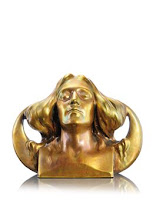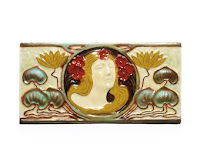Zsolnay Porcelain Manufactory
The upcoming  Christie’s sale of 20th Century Decorative Art & Design in London (on April 21, 2010) is full of wonderful Art Nouveau objects. Two things in particular clearly stand out: Carlo Bugtti’s furniture and ceramics from the Hungarian manufactory of Zsolnay. I first encountered this firm’s work, and wrote about it here, in the guise of “Venom” a snake from Yves Saint Laurent’s personal collection, at the IFAADS at the Park Ave Armory show in October. Jason Jacques had a wonderful collection of Zsolnay ceramics which he displayed at his booth (including “Venom”).
Christie’s sale of 20th Century Decorative Art & Design in London (on April 21, 2010) is full of wonderful Art Nouveau objects. Two things in particular clearly stand out: Carlo Bugtti’s furniture and ceramics from the Hungarian manufactory of Zsolnay. I first encountered this firm’s work, and wrote about it here, in the guise of “Venom” a snake from Yves Saint Laurent’s personal collection, at the IFAADS at the Park Ave Armory show in October. Jason Jacques had a wonderful collection of Zsolnay ceramics which he displayed at his booth (including “Venom”).
The Zsolnay Porcelain Manufactory was founded in Pécs, Hungary in 1853 by Miklos Zsolnay and has a long and rich history. The co mpany was a family business with the founder’s sons participating in the day to day activities of the factory, nurturing the company’s output and, finally, in 1873 participating in the World’s Fair in Vienna and in 1878 in Paris, where the manufactory was awarded with the Grand Prix or the gold medal. Other exhibition followed: Melbourne in 1880, Brussels in 1888, Chicago in 1893 and Antwerp in 1894.It was around t
mpany was a family business with the founder’s sons participating in the day to day activities of the factory, nurturing the company’s output and, finally, in 1873 participating in the World’s Fair in Vienna and in 1878 in Paris, where the manufactory was awarded with the Grand Prix or the gold medal. Other exhibition followed: Melbourne in 1880, Brussels in 1888, Chicago in 1893 and Antwerp in 1894.It was around t his time, in 1896 to be specific, that Zsolnay developed the eosin glaze (named after the Greek goddess of dawn, Eos), an iridescent finish used on the pottery that made their wares so desirable and the firm world renowned. The iridescent glaze looks similar to Tiffany’s favrile glass. According to the company’s website, the emperor awarded the Franz Joseph Order to Zsolnay’s youngest grandson, who was now in charge, and the city of Pécs gave him the title of Honorary Town Citizen! Both were very high honors.
his time, in 1896 to be specific, that Zsolnay developed the eosin glaze (named after the Greek goddess of dawn, Eos), an iridescent finish used on the pottery that made their wares so desirable and the firm world renowned. The iridescent glaze looks similar to Tiffany’s favrile glass. According to the company’s website, the emperor awarded the Franz Joseph Order to Zsolnay’s youngest grandson, who was now in charge, and the city of Pécs gave him the title of Honorary Town Citizen! Both were very high honors.
In the beginning of the 20th century, with the onset of the Art Nouveau movement, the company’s nature-inspired vases and bowls garnered quiet a following. Lots 1 and 4 are two of the most spectacular vases, in my opinion, and were both designed by Sandor Apati Abt (1870-1916), one of the factory’s designers. Zsolnay’s contribution to the Paris Exposition of 1900 was also significant. They created over 30 figures of Hussars, about 12.5 inches tall, in traditional attire for the Hunga rian Pavilion, as well as a figure of the Emperor Franz Joseph on a horse. And two of its designers, Apati Abt and Tádé Sikorski (1852-1940) were both awarded medals. Sikorski’s work is represented in the sale with lot 6, a beautiful linear blue vase with curvy handles.
rian Pavilion, as well as a figure of the Emperor Franz Joseph on a horse. And two of its designers, Apati Abt and Tádé Sikorski (1852-1940) were both awarded medals. Sikorski’s work is represented in the sale with lot 6, a beautiful linear blue vase with curvy handles.
Other than their discovery of eosin, Zsolnay also produced pyrogranite, which is another type of ceramic. When fired under a high temperature pyrogranite becomes acid and frost-resistant. This made it attractive to architects and designers who were looking for a durable material to use as decoration outdoors and so Zsolnay’s pyrogranite tiles were used to adorn the exteriors of the Matthias Church, the Hungarian Parliament Building, the Museum of Applied Art, the Geological Institute, the Kőbánya Church, and the Gellért Baths, all in B udapest. Lot 14 of the sale is an example of such a tile. The image of a woman with long, flowing hair is quintessential Art Nouveau.
udapest. Lot 14 of the sale is an example of such a tile. The image of a woman with long, flowing hair is quintessential Art Nouveau.
In 1914, the factory was the largest company in Austro-Hungary. The onset of World War I and World War II crippled the company’s productivity and in 1948, under Communism, the company was nationalized and remained this way until 1982. In the last decade, the company has regained its name and has started to build back its image. However, as usual, I prefer the old pieces to the new ones that are being produced today. There is a certain elegance that is missing from the new pieces.
Images all taken from Christie’s London 20th Century Decorative Art & Design auction catalogue. From top, left-right:lots 3, 4, 1, 16 and 14.
2 comments
Leave a Reply Cancel reply
Calendar
| M | T | W | T | F | S | S |
|---|---|---|---|---|---|---|
| 1 | 2 | 3 | 4 | 5 | 6 | 7 |
| 8 | 9 | 10 | 11 | 12 | 13 | 14 |
| 15 | 16 | 17 | 18 | 19 | 20 | 21 |
| 22 | 23 | 24 | 25 | 26 | 27 | 28 |
| 29 | 30 | 31 | ||||
Archives
- June 2018
- March 2018
- December 2016
- January 2016
- November 2015
- September 2015
- August 2015
- June 2015
- March 2015
- February 2015
- December 2014
- November 2014
- October 2014
- May 2014
- April 2014
- January 2014
- December 2013
- November 2013
- October 2013
- September 2013
- June 2013
- May 2013
- April 2013
- March 2013
- February 2013
- December 2012
- November 2012
- October 2012
- September 2012
- August 2012
- July 2012
- June 2012
- May 2012
- April 2012
- March 2012
- February 2012
- January 2012
- December 2011
- November 2011
- October 2011
- September 2011
- July 2011
- June 2011
- May 2011
- April 2011
- March 2011
- February 2011
- January 2011
- December 2010
- November 2010
- October 2010
- September 2010
- July 2010
- June 2010
- May 2010
- April 2010
- March 2010
- February 2010
- January 2010
- December 2009
- November 2009
- October 2009
- September 2009
- August 2009
- July 2009
- June 2009
Categories
- 20th c. design
- Architecture
- Art Deco
- Art Jewelry Forum
- Art Nouveau
- Auction
- Bard Graduate Center
- Blog update
- Brooklyn Metal Works
- Brooklyn Museum
- Ceramics
- Christie's
- Contemporary Art
- Contemporary Design
- Cooper-Hewitt
- Costume Institute
- Decorative Arts Calendar
- Design Exhibition Review
- Designer Spotlight
- Exhibition review
- Extraordinary lives
- Fashion
- Fashion exhibition review
- Fashion photography
- Film
- Fresh Talent
- Furniture
- Gallery Spotlight
- Glass
- ICP NY
- Italian Design
- Jewelry
- Lecture
- MCNY
- Metropolitan Museum of Art
- MoMA
- Museum at F.I.T
- Museum of Arts and Design
- Neue Galerie NY
- On the Market
- Paper Art
- Paris
- Phillips de Pury & Company
- Pinakothek de Moderne
- Platforma
- Public Art
- Rago
- Recently Published Articles
- Russian Decorative Arts
- R|R Gallery
- Sculpture
- Sotheby's
- Television
- Textiles
- Travel
- Uncategorized
- Upcoming Events
- Vintage Clothing
- Wiener Werkstatte
- Wright
Participation in World Fairs was always important for innovative decorative artists, so I am not surprised that Zsolany did well in Vienna 1873, Paris 1878, Melbourne 1880, Brussels 1888, Chicago 1893 and Antwerp in 1894. That iridescent sheen was superb then and is still superb now.
The National Gallery of Victoria had a super exhibition in the last couple of years, documenting the history of World Fairs, in text, photos and objects. Zsolany was a star exhibit.
I am sad that I missed the exhibit in Victoria. But you can't see them all. I just wish that they would travel such shows.
From what I have seen of Zsolany vases, they are just spectacular. I also traveled to Budapest several years ago and was so taken by the tile work in the Gellert Baths but I had no idea then that it was by Zsolany.